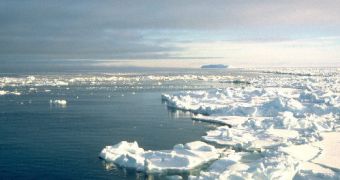It may be true that the Arctic sea ice is shrinking quite rapidly as a result of climate change and global warming, as many studies have shown, yet NASA researchers now wish to draw attention to a related peculiar phenomenon: the sea ice in the Antarctic is only getting bigger as the years go by.
According to the scientists who looked into this issue, starting with the year 1978 and up until 2010, the Antarctic sea ice added an average of 6,600 square miles to its total surface on a yearly basis.
The official website for NASA explains that this peculiar behavior of the Antarctic sea ice is most likely a direct result of the fact that, throughout the years, the ozone layer that covers this part of the world has been getting thinner.
Because ozone absorbs solar energy, it comes as no surprise that a decrease in its concentration in the Antarctic led to a cooler stratosphere, which in turn translated into an increased annual ice growth.
As well as this, the constant warming of the temperate latitudes altered the dynamics of circumpolar winds, thus contributing to a new pattern of ice formation and ice loss in the Antarctic.
Josefino Comiso, senior scientist at NASA Goddard, explains the situation as follows: “Winds off the Ross Ice Shelf are getting stronger and stronger, and that causes the sea ice to be pushed off the coast, which generates areas of open water, polynyas.”
Furthermore, “The larger the coastal polynya, the more ice it produces, because in polynyas the water is in direct contact with the very cold winter atmosphere and rapidly freezes.”
Apparently, this year's September witnessed both a record low for the Arctic ice cap, and a record winter maximum for the one in the Antarctic.
Still, NASA researchers wish to emphasize the fact that the overall melting rates for sea ice are considerably bigger than the growing ones.
“There's been an overall increase in the sea ice cover in the Antarctic, which is the opposite of what is happening in the Arctic. However, this growth rate is not nearly as large as the decrease in the Arctic,” climate scientist Claire Parkinson explained.
As Claire Parkinson goes on to argue, this annual increase in the Antarctic sea ice must not be regarded as proof that the global climate is not getting warmer as the years go by.
“The Earth is very large and the expectation definitely would be that there would be different changes in different regions of the world. That's true even if overall the system is warming,” this specialist wished to emphasize.

 14 DAY TRIAL //
14 DAY TRIAL //